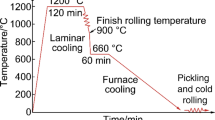Abstract
Based on exploring quenching mechanism, three types of quenching critical cooling rate models of medium-carbon steel and low-carbon steel and low-alloy construction steel were established, as modified Maynier model, Eldis model and isothermal curve model, respectively. During construction process, regression analysis and Newton interpolation method were used for higher calculated precision. Through comparing and analyzing, the superior one was selected to evaluate the full hardening thickness after quenching. According to hardness analyzing, the deviation between predicted hardness distribution and the experimental value is within 6%.
Similar content being viewed by others
References
PAN Jian-sheng, ZHANG Wei-min. Heat Treatment Mathematic Model and Computer Simulation [J]. Engineering Science of China, 2003, 5(5): 47 (in Chinese).
LIU Zhuang, WU Zhao-ji. Numerical Simulation in Heat Treatment Process [M]. Beijing: Science Press, 1996 (in Chinese).
Yu A Samoilovich, Nemzer A K Kabakov, E A Chesni Tskaya, et al. Austenitic Steel Phase Mathematical Model [M]. MиTOM, 1979, 9: 12.
WU Ji-xun, ZHOU Guang-yu. The Application Technology of Steel’s Hardenability [M]. Beijing: Mechanical Industrial Press, 1994 (in Chinese).
Maynier P H, Manager J D, Bastien P. Prediction of Microstructure via Empirical Formulae Based on CCT Diagrams [M]. New York: the Metallurgical Society/AME, 1978.
Siebert C A. The Hardenability of Steel [M]. LU Guang-xi, ZHAO Zi-wei, trans. Shanghai: Science and Technology Press, 1984 (in Chinese).
FAN Dong-li, WANG Guang-sheng. Heat Treatment Manual [M]. 3rd ed. Beijing: Mechanical Industrial Press, 2001 (in Chinese).
Gramge R A, Kiefer S M. Transformation of Austenite on Continuous Cooling and Its Relation to Transformation at Constant Temperature [J]. Trans of ASM 1941, 29: 85.
LU Xing. The Foundation of Heat Treatment Engineering [M]. Beijing: Mechanical Industrial Press, 2007 (in Chinese).
GUI Zhong-xi. Metallography and Heat Treatment [M]. Beijing: Mechanical Industrial Press, 2006 (in Chinese).
HU Guang-li, XIE Xi-wen. heat treatment of Steel (Theory and Techniques) [M]. Xi’an: Northwestern Industrial University Press, 2006 (in Chinese).
FAN Dong-li, XU Yue-ming, TONG Xiao-hui. Heat Treatment Technology Data Manual [M]. Beijing: Mechanical Industrial Press, 2006 (in Chinese).
WANG Zhao-dong, WANG Guo-dong. Heat Transfer Coefficient of Hot Rolled Strip During Ultra Fast Cooling Process [J]. Iron and Steel, 2006, 41(7): 54 (in Chinese).
YANG Shi-ming, TAO Wen-quan. Heat transfer Theory [M]. Beijing: Higher Education Press, 2001 (in Chinese).
Author information
Authors and Affiliations
Corresponding author
Additional information
Foundation Item: Item Sponsored by National Natural Science Foundation of China (50504007); National High-Tech Research and Development Program (863) of China (2003AA33G010)
Rights and permissions
About this article
Cite this article
Fu, Tl., Wang, Rq., Wang, Zd. et al. Construction and application of quenching critical cooling rate model. J. Iron Steel Res. Int. 17, 40–45 (2010). https://doi.org/10.1016/S1006-706X(10)60070-2
Revised:
Published:
Issue Date:
DOI: https://doi.org/10.1016/S1006-706X(10)60070-2




